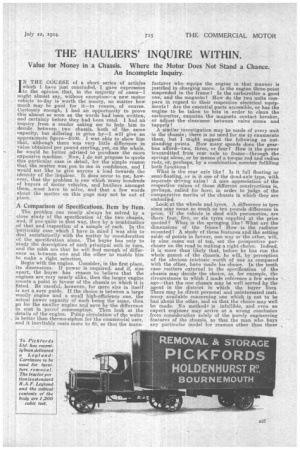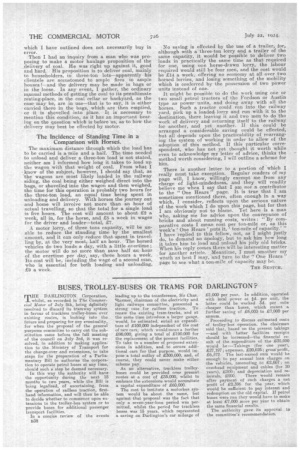THE HAULIERS' INQUIRE WITHIN.
Page 19

Page 20

If you've noticed an error in this article please click here to report it so we can fix it.
Value for Money in a Chassis. Where the Motor Does Not Stand a Chance. An Incomplete Inquiry.
IN THE COURSE of a short series of articles which I have just concluded, I. gave expression
• to the opinion that, in the majority of cases—I might almost say, without exception—a new motor • vehicle to-day is worth the money, no matter how much may be paid for it—in reason, of course. Curiously enough, I had an opportunity to prove this almost so soon as the words had been written, and certainly before they had been read. I had an inquiry from a reader asking me to help him to decide between two chassis, both of the same capacity, but differing in price by—I will give an approximate figure-1100. I was able to show him that, although there was very little difference in value obtained per pound sterling, yet, on the whole, he would be better advised to purchase the more expensive machine. Now, I do not propose to quote this particular case in detail, for the simple reason that the matter was put to me in confidence, and I would not like to give anyone a lead towards the • identity of the inquirer. It does occur to me, how. ever, that -the problem is one which many hundreds of buyers of motor vehicles, and hauliers amongst them,, must have to solve, and that a few words about the matter on this page may not be out of place.
.A. Comparison of Specifications, Item by Item.
The problem can nearly always be solved by a close study of the specification of the two chassis, and, if notquite in that way, then by a combination of that and inspection of a sample of each. In the • 'particular case which I have in mind I was able to deal satisfactorily with the matter by consideration of the specification alone. The buyer has only to study the description of each principal unit in turn, and the odds are that he will find enough of difference as between one and the other to enable him to make a right selection. Begin with the engine. Consider, in the first place, its dimensions. If power is required, and if, size apart, the buyer has reason to believe that the engines are very nearly alike, then the larger engine counts a point in favour of the chassis to which it is fitted. Be careful, however, for mere size in itself . is not a sure guide. If the choice is between a large woolly engine and a small high-efficiency one, the actual power capacity of each being the same, then go for the smaller engine and save by the difference in cost in petrol consumption. Then look at the details of the engine. Pump circulation of the water . is better than thermo-siphon for the commercial user,and it inevitably costs more to fit, so that the manit
facturer who equips the engine in that manner is justified in charging more. Is the engine three-point suspended in the frame 1 Is the carburetter a good one, and the magneto? How do the two units compare in regard to their respective electrical equipments? Are the essential parts accessible, or has the engine to be taken to bits in order to clean the carburetter, examine the magneto contact breaker, or adjust the clearance between valve stems and tappets ?
A similar investigation may be made of every unit in the chassis ; there is no need for me to enumerate them, I but I might suggest the following as outstanding points. How many speeds does the gearbox afford—two, three, or four I How is the power transmitted_ from rear axle to frame—through the springs alone, or by means of a torque rod and radius rods, or, perhaps, by a combination member fulfilling both functions ?
What is the rear axle like ? Is it full floating or semi-floating, or is it one of the dead-axle type, with separate driving axles? A nice appreciation of the respective values of these different constructions is, perhaps, called for here, in order to judge of the comparative merits of the chassis in which they are embodied.
Look at the wheels and tyres. A difference in tyre sizes May mean so much as ten pounds difference in price. If the vehicle is shod with pneumatics, are there four, five, or six tyres supplied at the price quoted? What is the springing like ? What are the dimensions of the frame? How is the radiator mounted? A study of these features and the setting aside of points in favour, one way or the other, will, in nine cases out of ten, set the prospective purchaser on the road to making a right choice. Indeed, it is more than likely that, before he has run the whole gamut of the chassis, he will, by perception of the obvious intrinsic worth• of one as compared with the other, have made his choice. In the tenth case matters external to the specification of the chassis may decide the choice, as, for example, the circumstance to which I made reference a few weeks ago—that the one chassis may be well served by the agent in the district in which the buyer lives. There may be direct personal and uninterested testimony available concerning one which is not to be had about the other, and on that the choice may well be made. No method' is infallible, and even an expert engineer may arrive at a wrong conclusion from consideration solely of the purely engineering features of the chassis, so that the man who buys any particular model for reasons other than those
which I have outlined does not necessarily buy in error.
Then I had an inquiry from a man who was proposing to make a motor haulage proposition of the delivery of coal. He was right up against it, good and hard. His proposition is to deliver coal, mainly to householders, in three-ton lots—apparently his clientele are accustomed to ample fires in ample houses 1—andthe delivery may be made in bags or in the loose. In any event, I gather, the ordinary naanual methods of getting the coal to its penultimate resting-place, in the coal cellar or backyard, as the case may be, are in use—that is to say, it is either carried there in the bags, which are then emptied, or it is shovelled into place. It is necessary to mention this condition, as it has an important bearing on the question which is before us, as to how the delivery may best be effected by motor.
The Incidence of Standing Time in a Comparison with Horse.
The maximum distance through which the load has to be carried is it mile and a half. The time needed to unload and deliver a three-ton load is not stated, neither am I informed how long it takes to load up the wagon with that weight of coal. From what I know of the subject, however, I should say that, as the wagons are most likely loaded in the railway siding, the coal being either weighed direct into the bags, or shovelled into the wagon and then weighed, the time for this operation is probably two hours for the three-ton load, an equal time being spent in unloading and delivery. With horses the journey out and home will involve not more than an hour of actual travelling, so that the total for a single load is five hours. The cost will amount to about £2 a week, all in, for the horse, and 25 a week in wages for the driver and loader—total, 27.
A motor lorry, of three tons capacity, will be unable to reduce the standing time by the smallest amount, and it can only reduce that spent in travelling by, at the very most, half an hour. The horsed vehicles do two loads a day, with a little overtime ; the motor will do no more than save half an hour of the overtime per .day, say, three hours a week. Its cost will be, including the wage of a second man, who is essential for both loading and unloading, £9 a week.
No saving is effected by the use of a trailer, for, although with a three-ton lorry and a trailer Of the same capacity, it would be possible to deliver two loads in practically the same time as that required for one, using one horse-drawn lorry, the labour required would still be four men, and the cost would be 214 a week, offering no economy at all over two horsed lorries, and losing something of the mobility which is conferred by the possession of two power units instead of one.
It might be possible to do the mirk using one or two small petrol tractors of the Fordson or Austin type as power units, and doing away with all the horses. Such a traetor could run into the railway yard, pick up a loaded lorry and run with it to the destination, there leaving it and two men to do the work of delivery and returning itself to the railway for another, and yet another. If this could be arranged a considerable saving could be effected, but all depends upon the practicability of rearranging the system of working in order to allow of the adoption of this method. If this particular correspondent, who has not yet thought it worth while even to acknowledge my letter of advice, thinks the method worth considering, I will outline a scheme for him.
There is another letter to a portion of which I really must take exception. Regular readers of my page will, I know, willingly exempt me from any charge of light-mindedness, and they will readily believe me when I say that I am not a contributor to the " One Hears " page. It is true that I ant sometimes mentioned there, often enough in a way which, I consider, reflects upon the serious nature of the work which I do upon this page, but for that I am obviously not to blame. Yet here is a man who, asking me for advice upon the conveyance of bricks and about running costs, writes : " By comparative costs I mean cost per ton-mile or, as this week's ' One Hears' puts it, ton-mile of capacity.' " I have replied to this fellow, not, as I might justly do, to demand an apology, but to ask him how long it takes him to load and unload his jolly old bricks. When his reply comes there will be interesting matter for another article. Meantime, I must smother my wrath as best I may, and turn to the " One Hears" page to see what a ton-mile of capacity may be.
THE SKI:ITCH.






























